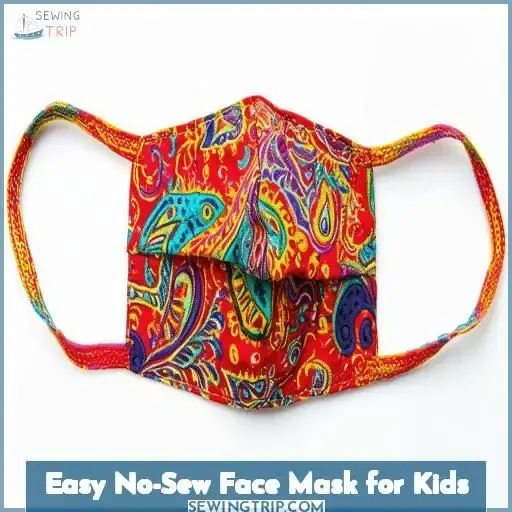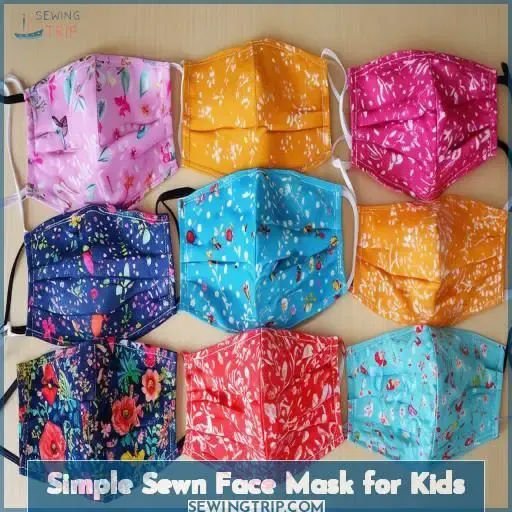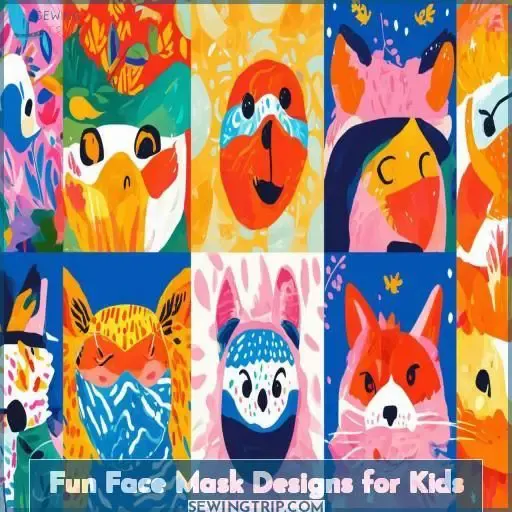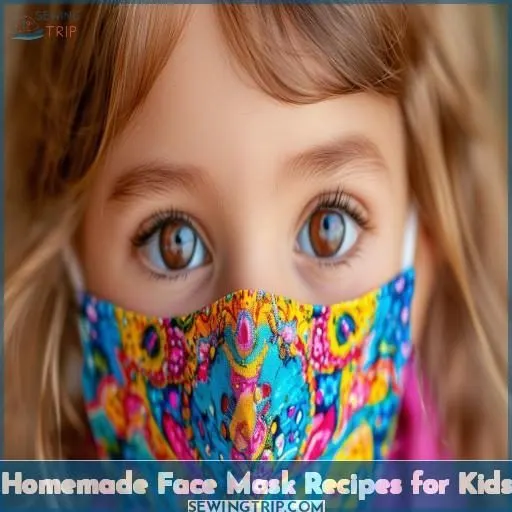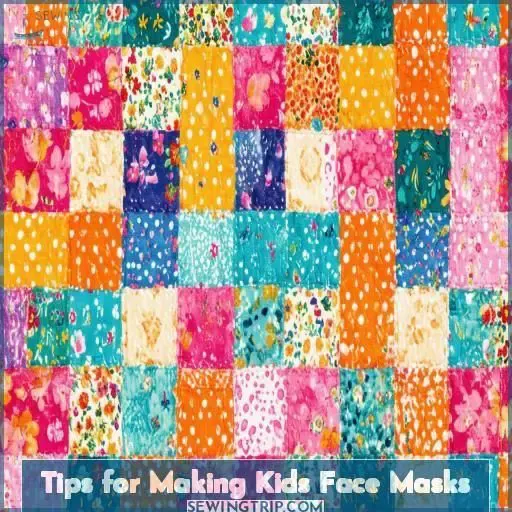This site is supported by our readers. We may earn a commission, at no cost to you, if you purchase through links.
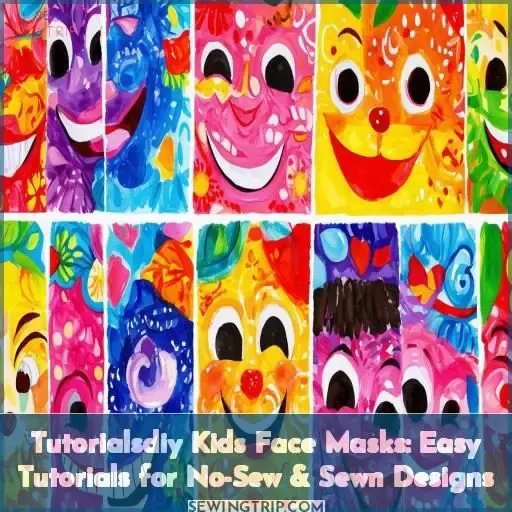 Need a fun DIY project to keep kids entertained? Create adorable and practical kids face masks!
Need a fun DIY project to keep kids entertained? Create adorable and practical kids face masks!
With simple no-sew or sewn options, you can whip up protective masks customized to your little one’s interests.
For the crafty kids, try superhero, animal, or emoji designs using felt cutouts or tie-dye patterns.
Not a sewing pro? No worries! Our easy no-sew tutorial walks you through each step.
Get your supplies ready and let’s get started on these customized face masks that’ll make wearing them a joy.
Who knows, you might discover a new family tradition!
Table Of Contents
Key Takeaways
- Who needs a cape when you’ve got a superhero mask? Embrace your child’s inner crusader with custom logos and comic-inspired designs – just don’t let them go jumping off any buildings!
- Calling all party animals! Leopard, zebra, or monkey prints galore. These adorable animal masks put a safari spin on staying safe and looking absolutely roarsome.
- Ooh, emojis! Turn those little frowns upside down with fun, expressive emoji masks. The possibilities are endless for creative kids who like to wear their feelings on their face coverings.
- Ditch the store-bought goop and treat your tiny tot to a homemade spa day with nourishing banana-honey and oatmeal-coconut oil masks. The kitchen is their new beauty parlor!
Easy No-Sew Face Mask for Kids
You’ll need just a few household items like fabric, scissors, and hair ties or rubber bands for this simple no-sew face mask project. Start by cutting a rectangle from an old t-shirt or other soft fabric, fold it in half, and secure the loops with hair ties or rubber bands for an easy, no-sew kid-friendly face covering.
Materials Needed
To create an easy no-sew face mask for kids, you’ll need two squares of tightly woven quilting cotton for each mask, and either elastic for ear loops or bias tape for ties. (Source)
This approach allows for easy customization, ensuring a comfortable fit for the kids.
Prioritizing safety, these homemade facial masks offer a simple solution for keeping children protected in various situations.
Step-by-Step Instructions
To make a no-sew face mask for kids, place two charm squares wrong sides together.
Create two pleats, secure with clips, and zigzag or serge around the edge (Source).
Then cut two pieces of elastic, tie knots at the ends, and secure them in place by zigzagging over the top inside corner of one side .
Simple Sewn Face Mask for Kids
You’ll need a few basic sewing supplies to make a simple sewn face mask for kids – quilting cotton, elastic, thread, and notions like scissors and pins. Follow the cutting instructions to size the fabric and elastic pieces appropriately based on your child’s age, then move onto sewing and pleating to assemble the mask.
Supplies
To create a simple sewn face mask for kids, you’ll need a few basic supplies: 2 pieces of quilting cotton fabric, 1/8 braided or flat elastic, a sewing machine, thread, a cutting mat, rotary cutter, ruler, straight pins, an iron, and scissors. Choose tightly woven cotton for the best fit and protection. Customize the mask with fun fabrics your child will love!
Cutting Instructions
To cut the fabric for your kids’ face mask, use a rotary cutter, ruler, and straight pins. Choose tightly woven quilting cotton. Cut two fabric pieces in the desired size: Small (4 1/2 x 6), Medium (5 x 7), Large (5 1/2 x 8), or Adult (6 x 9). Cut two elastic pieces (5 1/2 to 7 inches long) for the ear loops.
Sewing Instructions
Sewing a simple face mask for kids is a breeze!
Place the fabric pieces right sides together and sew around the perimeter with a 1/4 inch seam allowance.
Insert the elastic 3/8 inch from the corners and sew through.
Leave a 1 1/2 inch gap for turning, then turn the mask right-side-out and press.
Get creative with fabric choices and elastic options for a custom fit!
Pleating Instructions
To create pleats for the kids’ face masks, start by folding the short ends to make two even pleats on each end.
Pin the pleats in place securely.
Next, topstitch around the perimeter to secure the pleats.
To reinforce the pleats, sew across them three times.
These pleating instructions will add a professional touch to the face mask’s design, allowing for embellishments, such as embroidery and decorations, while ensuring a secure and comfortable fit.
Fun Face Mask Designs for Kids
You can turn ordinary face masks into fun and creative designs that kids will love! From superhero masks with felt logos to adorable animal masks featuring ears and noses, there are plenty of simple ways to customize reusable face coverings.
Superhero Masks
Foster your child’s inner superhero with custom face masks! Craft masks featuring iconic superhero logos, comic book characters, or even their favorite hero’s costume. Encourage creativity by letting them decorate their mask with markers, glitter, or fabric scraps. Monkey see, monkey hear, monkey do – they’ll love wearing their superhero mask and feeling like a real-life crime fighter!
Animal Masks
Ignite your child’s playful spirit with adorable animal face masks! Crafted from gentle, non-irritating materials, these unique designs boast charming animal prints that will have them roaring with joy. Breathable fabrics provide comfort, while patterned options like leopard or zebra add a touch of flair. Combine with a homemade banana and honey mask for a fun, nourishing treat!
Emoji Masks
Create fun and expressive emoji face masks for kids with engaging designs and creative embellishments.
Select kid-friendly fabric patterns to craft masks featuring popular emoji expressions.
Explore various themes and variations such as happy, sad, and laughing emojis to make the mask-making process interactive and enjoyable for children.
Incorporate these ideas to add a touch of character and excitement to the face masks.
Tie-Dye Masks
Discover the creative world of Tie-Dye Masks for Kids, exploring vibrant colors and unique patterns. Experiment with various tie-dye methods to craft exciting design variations. Choose from a range of fabric choices to achieve the perfect look for your little ones. Engage in the fun world of tie-dye, creating colorful and one-of-a-kind masks for your kids to enjoy!
Homemade Face Mask Recipes for Kids
If you’re looking to pamper your kids with some homemade skincare, try whipping up a nourishing banana and honey face mask, an applesauce and olive oil blend to hydrate dry skin, or an oats and coconut oil treatment to soothe irritation. These simple recipes leverage common kitchen ingredients to create gentle, natural skincare solutions perfect for young complexions.
Banana & Honey Face Mask
Whip up a nourishing banana and honey face mask for your little one! Mash a ripe banana and mix in a spoonful of honey. Apply the creamy blend to their face and let it work its magic for up to 30 minutes. Rinse with a warm washcloth to reveal soft, refreshed skin. This easy DIY is:
- Packed with skin-loving nutrients
- A fun activity for kids
- Made with ingredients you likely have on hand
Applesauce & Olive Oil Face Mask
To make an effective homemade face mask for kids, try the Applesauce & Olive Oil Face Mask recipe.
This mask provides gentle nourishment for the skin, combining the benefits of applesauce and olive oil. It’s especially beneficial for kids with food sensitivities and offers a natural solution to skin irritation.
Using common kitchen ingredients, this mask doubles as a healthy and easy-to-make toddler snack.
Oats & Coconut Oil Face Mask
Whip up a soothing oats and coconut oil face mask for your little one’s delicate skin! Grind oats into a fine powder, mix with melted coconut oil, and apply to clean skin. Let it sit for 10-15 minutes before rinsing. The oats gently exfoliate while coconut oil’s fatty acids deeply moisturize, leaving skin soft and nourished.
- Grind oats into a fine powder
- Mix with melted coconut oil
- Apply to clean skin and let sit for 10-15 minutes
- Rinse off for soft, nourished skin
Tips for Making Kids Face Masks
When creating DIY face masks for kids, choose fabrics that are breathable and comfortable, like 100% cotton.
Adjust the mask size properly – too small can cause discomfort, while too big might not provide adequate coverage.
Decorate masks with fun prints, appliques, or let kids get creative with fabric markers to make them more appealing.
Always wash cloth masks regularly with hot, soapy water, and store them in a clean, dry place between uses.
Choosing Fabric
When choosing fabric for kids’ face masks, opt for tightly woven quilting cotton as recommended by experts for its effectiveness in filtration and breathability. (Source)
Consider color options and pattern choices based on your kids’ preferences.
Make sure the fabric’s texture is comfortable for prolonged wear.
Evaluate material comparison to select the most suitable option for safety and comfort.
These considerations will contribute to creating functional and enjoyable masks for your kids.
Adjusting Fit
Adjusting the fit is key for comfort and effectiveness. Experiment with pleat placement to customize the size. Use elastic or ties that are long enough to loop behind the ears or tie at the neck. Choose a fabric with some stretch for a snug yet breathable fit. Adding a bendable nose wire helps create a secure seal.
Decorating Masks
Foster your child’s creativity by decorating their face masks! Use fabric markers or paint to add fun designs like rainbows, stars, or their favorite characters. Glue on sequins, stickers, or patches for a personalized touch. Sew on ribbons or lace for a fancy flair. The possibilities are limitless to make mask-wearing more enjoyable!
Cleaning Masks
Washing your child’s face mask regularly is essential for hygiene and safety. Use hot, soapy water** and scrub both sides thoroughly. Rinse completely to remove all soap residue. Air-dry the mask in direct sunlight if possible, as UV rays help disinfect. If machine-drying, use the highest heat setting. Properly disinfecting and sterilizing masks keeps your little one protected.
Storing Masks
To keep your kids’ face masks fresh and ready to wear, store them in a cool, dry place away from direct sunlight. Rotate masks regularly to prevent odors and extend their lifespan. For long-term storage, consider using breathable fabric bags or boxes to protect the material from dust and damage. With proper storage, your kids’ masks will stay clean, comfortable, and ready for use whenever needed.
- Use breathable fabric bags or boxes for storage
- Rotate masks regularly to prevent odors
- Store in a cool, dry place away from sunlight
Frequently Asked Questions (FAQs)
How to make an easy face mask for kids?
Grab two fabric squares, elastic, and pins. Fold squares in half, insert elastic, and sew three sides. Flip inside-out and pleat sides. Sewing masks allows creativity while keeping kids safe.
How do you make a 3 ingredient face mask?
Ever craved a fresh face mask your kids will love? Mash 1/2 ripe banana with 1 tbsp honey. Smooth this nourishing treat over clean skin, let sit 15 minutes, then rinse. Soft, glowing skin awaits – the perfect pick-me-up!
How do you make a simple homemade face mask?
To make a simple face mask at home, cut rectangular fabric pieces for the mask body and elastic or fabric ties for the ear loops. Sew the pieces together, leaving room to insert the elastic or ties. Finish by securing the ties.
How to make a dust mask for kids?
Make simple dust masks by folding fabric rectangles, adding pleats, and attaching elastic ear loops. Use breathable cotton and adjust sizing for kids. Sew or glue for durability. Get creative with fun patterns!
How often should kids wash their homemade face masks?
You should wash your kids’ homemade face masks regularly—ideally daily or after each use. Proper cleaning helps reduce the spread of germs and keeps the masks fresh. Follow the fabric care instructions, and let the masks fully dry before reusing.
Can kids wear face masks while exercising or playing sports?
At soccer practice, Kelly felt hot under her homemade mask. If kids exercise vigorously or play sports, masks aren’t recommended – they can restrict breathing. For low-intensity activities, masks are fine, but watch out for overheating.
Are there any special considerations for kids with asthma or allergies?
If your child has asthma or allergies, consult their doctor before using face masks. Masks may exacerbate breathing issues or trigger allergic reactions. Consider alternative protective measures if advised against mask usage.
How can I make face masks more comfortable for my child?
Like Dorothy’s ruby slippers, adjusting the fit can make kids’ masks way more comfy. Try adjustable ties or loosening elastic for a snug yet breathable seal. Adding soft cotton lining feels dreamy too!
Are there any alternatives to elastic for the ear loops?
Yes, you can use bias tape or fabric ties instead of elastic for the ear loops. They’re more breathable and adjustable for kids’ comfort.
Conclusion
Ignite your imagination with these tutorials for DIY kids’ face masks!
From superhero to animal designs, these masks provide both fun and protection.
Embrace the joy of crafting with your little ones, creating lasting memories.
Customize each mask to match their personalities, making wearing them an exciting adventure.
Explore our no-sew and sewn options to find the ideal DIY project for your family’s needs.
Get ready to start a creative journey that’ll yield practical yet delightful face masks!

